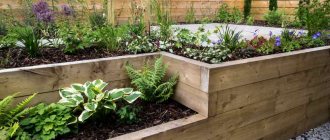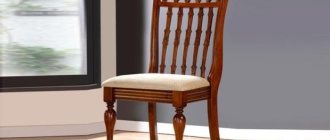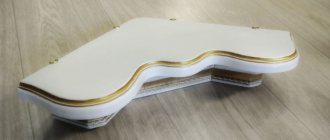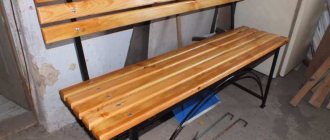Alpine slides are increasingly appearing on personal plots, squares, and recreation areas. The landscape composition of boulders, a waterfall, and plants resembles a piece of a mountain landscape that delights with bright blooms from spring to autumn. The combination of rough rocks and delicate flowers, emerald grass creates a feeling of serenity and a piece of exotic wild nature. To build an alpine slide, you don’t need the skills of a landscape designer, just enough patience and physical strength to lay out rocky structures and plant flowers. You can see interesting solutions in photographs, and then adapt them to the landscape and site design. Creating a rock garden with your own hands is an exciting process; as the hill becomes populated with vegetation, new ideas appear, the landscape composition is complemented by lamps and clay pots.
What it is?
Alpine slide is a composition in landscape design that demonstrates a piece of the mountain landscape.
Alpine slides consist of stones and flowers and can be supplemented with shrubs, garden decorative elements, even waterfalls. There is another type of similar decoration in the landscape - rockery. But unlike a slide, it is flat. Creating a rock garden requires elevation and descent - that's why it is called a slide.
In the photo there is a rock garden on the site
Necessary materials
The main material for the alpine composition is stones. To backfill and create drainage you will need sand, crushed stone, limestone, and gravel. The soil is prepared for the plants. Peat is needed for mulching.
Since the slide will have a pond, it is better to select rocks. They have low porosity and weakly absorb water. Specimens with unusual, quirky shapes are perfect. For classic design, stones of the same type are used. The combination is made through different shapes. For complex design projects, multi-colored stones are chosen. If they have cracks, the defects are hidden in the ground.
Important! Shell rock and dolomite are not suitable for a slide with a pond. Stones have a porous structure and absorb water like a sponge, which contributes to their rapid destruction.
Where is the best location on the site?
Most often, an alpine slide in a dacha is moved to the edge of the site or moved to a corner, installed near the fence: when choosing this option, make sure that the main slope is oriented to the south. This way, plants located on a stone hill will always have enough sun.
Check out our selection of climbing plants for a fence.
In the photo there is a stone slide near the fence
The second option is near the path. A towering alpine flowerbed effectively emphasizes the landscape and sets the dynamics of the garden area.
Option number 3 - in the center of the site. Suitable for those who focus on decor and prefer to sow the garden space with lawn grass. A high alpine hill surrounded by a flat lawn looks original and attracts attention. It will definitely become the main accent of the landscape.
The last option is no less interesting than the previous ones: if you still have a free area or an unused corner near the house, plant a rock garden in this place.
Important! In a small area, designers do not recommend central placement: to save space, an alpine slide can be placed near a fence, against the wall of a building, or in a corner of the area.
Decorating a pond
They think about decorating a pond with an alpine composition even at the stage of its creation. Reservoirs are distinguished by type of shape:
- correct;
- wrong.
The correct form includes ponds with strict adherence to geometric shapes. Reservoirs usually correspond to the design elements of the site and are harmoniously combined with the architectural ensemble. Along the perimeter of the pond and the approach to it, paving slabs are laid out.
Ponds of irregular shape are more decorative. They allow the creator's imagination to be fully expressed.
Reservoirs differ in their location levels:
- Raised ponds are usually small and have a strict geometric shape. To create them on an alpine composition, a minimum of earthwork is required.
- Recessed ponds resemble a natural pond with natural shapes. The water surface is flush with the ground.
When thinking about the decor of a pond, you need to know about one more difference. Landscape ponds create the closest possible resemblance to natural lakes. Designer ponds are decorated to suit a specific style: they create an unusual shape and plant exotic plants.
What can you decorate with?
Let's start with the fact that the slides themselves, as a rule, look very attractive. But if just stones and plants are not enough for you, you can resort to brighter accent solutions.
Light stones or sand
Snow-white pebbles or broken marble chips, as well as light sand, are ideal for laying around the perimeter or filling voids in the composition. On a sunny day, they will literally glow in the sun, attracting attention. And even in a cloudy background, such a background is pleasing to the eye; an alpine flowerbed in a white robe looks more elegant.
Garden figurines
When purchasing ready-made decorations, you need to consider the style or direction of the slide design. For example, in the classical style, plaster statues are combined with light marble chips. Country style is characterized by wooden elements.
Thanks to the figures, they recreate entire scenes from their favorite fairy tales or cartoons.
In the photo there are garden figurines made of wood
Tree
In terms of naturalness, wood has no equal: it easily fits into the desired plot or design of the slide. Use slabs, saw cuts, hemp, logs, and branches for decoration.
Water
Rock gardens and ponds are like two halves of one whole. You can make a shallow pond at the base of the slide or lay out tiers for a waterfall in the slide itself. In the second case, be sure to take care of drainage so that the roots of the plants do not rot due to constant contact with water.
Advice! If you are afraid to create a real waterfall, start with a dry stream: an imitation is made from stones or plants.
Decorative design
Decor made from natural materials, artificial ponds, and lighting give the rock garden a unique look. The mountain landscape will be complemented by dry streams. With proper arrangement, it seems as if a stream of water has recently flowed along the dry riverbed. The source of the stream should come out from under a large block, the mouth should be hidden in green spaces and large leaves. The water surface is imitated with pebbles and fine gravel.
Alpine slide with pond
A pit is dug for the pond and the walls are insulated with butyl rubber film. A small pond can be made from a car tire or a special fiberglass liner, which is placed in a pit that follows the shape of the sides. For a stream flowing along a stone bed, a pump is installed in the pond and connected to a water supply hose. For the cascade, take flat stones, fasten them with polyurethane foam, and cover the seams with small fragments. A small fountain will decorate the rock garden and create coolness. To make work easier, buy a pump with a built-in filter. The unit is installed in a container, filled with water, and turned on according to the instructions. To create a fountain without a pump, a water pipe is led into a pond. Water can be diverted to the garden for irrigation.
Slide lighting
A rock garden illuminated by mini-spotlights or LED lamps on pegs looks impressive in the evening. Lamps with a wide scattering angle illuminate shrubs, while directional lamps illuminate flowers and foliage. The simplest lighting option is solar-powered lanterns. The absence of a cable gives freedom of action; lighting fixtures can be installed on each tier, illuminating a pond or terrace. Ground lamps can be used to outline the contour of a picturesque area or highlight shrubs. Underwater lighting with lamps of different colors visually increases the volume and colors the water. Floating solar-powered ball lamps move freely around the pond.
The lanterns will be replaced and the outline of the alpine slide will be illuminated by stones and pebbles coated with luminescent paint.
Setting up an area for reading or drinking tea
Behind a fragment of mountain nature there is a lawn for relaxation. For comfort, two sides are framed with a green wall of deciduous shrubs, low-growing varieties of cypress and thuja, which reach 80-90 cm. A platform with smooth contours, strewn with gravel or paved with the same material as the paths, is combined with the rock garden. The recreation area is equipped with rattan garden furniture. For the table, a slab (large slab) of rock is laid on a base of blocks. Original tables and benches are made from gabions and boards. Such options create a feeling of harmony and integrity. For reading by the pond, you can place a tray on the stones. A stone outdoor fireplace will warm and decorate the area.
How to do it yourself?
Do-it-yourself Alpine slide is a reality. To recreate the mountain landscape on the site, the main thing is to strictly follow the instructions.
Step-by-step instruction
Selecting a location
Draw up a diagram of the site, indicating static structures and the location of the cardinal directions. For a slide you need a bright, free area of a suitable size - but the bigger the better.
Important! The creation of a rock garden begins in the fall - only by spring it will be ready for planting.
Preparation
Forming the height of the rock garden begins with drainage. First of all, the site needs to be leveled and compacted. Lay a mixture of sand and crushed stone on the ground, forming the top in the right place, the levels of the future structure. The drainage should also be compacted and covered with soil - the composition is selected for the plants that are planned to be planted.
Shrinkage
At this stage, nothing needs to be done - the “blank” is left until spring, until natural deformation occurs.
Working with stones
Start with the largest ones, sinking them into the ground by 35-50%. Small stones are placed next to large ones so that they do not slide down the hill during rains or melting snow. Form the desired composition, leaving room for greenery.
Landing
Plants are planted according to the same principle as stones: first large, then small. Tall shrubs are moved closer to the top, low creeping ones are located at the foot. Maintain symmetry - the entire width of the slope should be decorative.
After completion of the work, new residents need to be watered and the free soil mulched with bark or stones. This will make the composition complete and will help avoid the appearance of weeds and facilitate further care.
Video instructions for beginners
If you are going to decorate the alpine zone exclusively with coniferous plants, be sure to watch the video instruction “10 steps in creating an alpine zone from conifers”:
Choosing a location for an alpine slide, layout diagrams
When choosing the area where the decor will be located, they rely not only on its visibility on the territory, but also on several other significant factors:
- The size of the slope must have an angle of at least 10-15 degrees.
- The slide should be harmonious in size: a small slide should not be made too high, and a wide one should have enough empty free space around it.
- The area must have a well-separable top layer of soil. Ideally, it is loose and previously dug up.
- It is allowed to independently create a slope by pouring sand or fine screenings.
Diagram of the structure of the reservoir Source idachi.ru
A uniform arrangement of plants in a rock garden will look banal, so it is better to plant the seeds in a chaotic manner. Of course, flower beds with soil must be prepared in advance for them.
Stage of placement of stones and vegetation Source lanshaft.com
Laying out the levels in an alpine slide is done with large cobblestones with a similar structure. Such a structure rises to several levels with a small height. The drainage layer should be the same for any terrace, but no more than 40-50 cm.
Correct installation of drainage depending on the ground level Source chrome-effect.ru
The height from the foot of the slide to its highest point can be 0.6-0.8 m. In some cases it is made higher, provided that the foot is wider. The top is always a solid point (rock, pebble).
Correct calculation of the size of steps Source optolov.ru
A rock garden with a waterfall and a small pond nearby is usually installed on the lawn, and non-flowering perennial plants are planted on top. To equip a reservoir, you need a pump and a small pit.
Care instructions
The process of caring for an alpine flower bed is quite simple; it can be roughly divided into seasons, each of which has a separate list of tasks:
- Spring. Remove covering material, repair damage, apply fertilizer. If necessary, plant annuals or bulbs.
- Summer. The main thing is to water regularly. In addition, remove weeds, clear the rock garden of fallen leaves and diseased plants, and trim the bushes.
- Autumn. Dig up bulbous plants, plant perennials, cover the plants for the winter.
- Winter. In winters with little snow, add snow yourself so that the slide retains its appearance.
Season for rock garden
Any season except winter is suitable for making an alpine jacket. In frosty conditions and snowstorms, it’s unlikely that anyone will want to work outside. The optimal time to postpone the work is early autumn. During this period, the harvest has already been harvested, and it is still too early to prepare the site for winter. Therefore, you will have time to improve the territory.
Another reason why it is better to start work in the fall is that the rock garden needs several months to shrink. If you finish before the beginning of winter, in the spring and summer all the errors in the shrinkage process will “come out” and need to be corrected. This must be done before planting the flora. If your planting is scheduled for September - October, start the arrangement accordingly in the spring.
The construction of something dictates its own rules. And our case is no exception. We will talk about these rules further. Let's go through the intricacies step by step. For a better understanding of the information, see the photo.
Beautiful design ideas for inspiration
Observation is a guarantee that you will be able to create a beautiful rock garden on your site. Just copy the ideas you like and recreate them.
For example, white stones do not have to be small - large boulders look no less elegant.
If the site already has a slope, take advantage of the natural landscape to create a slide.
Cobblestones can be not just large, but very large - as in the photo below. Flowers against their background look very contrasting.
An unusual option is to decorate with stones. You can use carved figures or just beautiful stones. It looks original if you put flat plates on the end.
And lastly, succulents. They do not require complex care and get along well on rocks and in poor soils. Stone roses and sedums can even overwinter in the garden, recovering beautifully with the arrival of warmer weather.
An alpine flowerbed is a spectacular decoration for a site. It’s not difficult to create - the main thing is not to be afraid to experiment!
Pond or stream
It is important that there is enough space. If possible, use round stones to design a miniature pond. The pond should also look as natural as possible. It is better not to use plastic containers whose edges are clearly visible.
Remember that a mountain garden stands and does not fall over with the right plants. As a rule, “less is often more.” Don't choose too many different plants. It is better to use several types or varieties over a large area. The same plants in different places on a hill can look beautiful and beneficial. It is also important that something is always blooming.
An example of a rock garden combined with a pond and a waterfall. Note the rounded shape of the stones
Don't shy away from the green color between the stones. The selection of plants should be made from the same row as for the design of a regular slide. Suitable for the alpine landscape : cinquefoil, gentian, heather, carnation, fern. Many mountain plants are widely available for sale, and you can get some yourself.
They are easy to care for, undemanding, easy to get along with and are content with a small amount of nutrients. And the washed gravel that fills the gaps between the pebbles will give the alpine garden a well-rounded, beautiful and natural atmosphere.
Alpine slide suitable for every site
An important factor is the uneven surface and favorable slope. Especially large plants look good between stones. Plants should be chosen so that at least one always blooms. Proper soil is vital for good plant development.
Greens for stones
What distinguishes a rock garden from an ordinary flower garden is a well-chosen set of floral, coniferous and artisanal plants.
The main requirements for it are decorative qualities, unpretentiousness, long flowering. When planting flora, it is advised to take into account the ratio: 1 coniferous plant, 2 shrubs, 3-4 flowering plants. They are planted starting from the top, gradually descending to the foot. The soil around the plants is mulched with fine crushed stone. This will retain moisture and protect the sprouts from weeds.
Not all flowers growing in flower beds are suitable for alpine hills. Preference is given to perennial, slow-growing and frost-resistant species. According to the growth form, low-growing, creeping and ground cover flowers are chosen.
The rock garden is visually divided into three tiers and each has its own climatic conditions.
The upper tier is more susceptible to winds and drought than others. Therefore, you need to place flowers on it that love the sun and are not afraid of drafts and lack of moisture. These can be edelweiss, bergenia, echinacea and lavender.
The average level is characterized by moderate humidity and not much light. Chest, Carpathian bell, hosta, purslane and young (stone rose) feel good in such conditions. The last two species are ideal settlers for a stone hill. They live well in rocky crevices.
Plants that love moisture and shade will take root on the third tier. Indian duchesnea, primrose, thyme (thyme), awl-shaped phlox, and saxifrage will bloom in lush colors in such conditions.
Also, to simulate a natural landscape, carnations, cinquefoil (St. John's wort), violet, low-growing iris, rhodiola, periwinkle and marigolds are planted.











